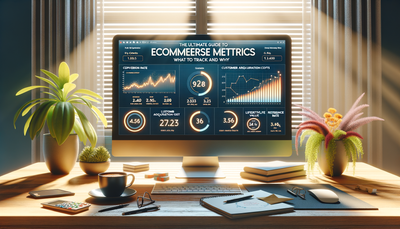Creating a Resource Center for Your B2B Website
In the competitive world of B2B marketing, establishing your company as a trusted industry leader is crucial. One effective way to achieve this is by creating a resource center on your website. A well-curated resource center can serve as a valuable hub of information for your target audience, showcasing your expertise and providing solutions to their challenges. This article explores the benefits of adding a resource center to your B2B website and offers guidance on how to curate content that will engage your audience, establish thought leadership, and generate quality leads for your business.Table of Contents:
-
The Importance of a Resource Center for B2B Websites
- Types of Content to Include in Your Resource Center
- Establishing Thought Leadership Through Your Resource Center
- Generating Leads Through Your Resource Center
- Organizing and Presenting Your Resource Center
- Measuring the Success of Your Resource Center
- Types of Content to Include in Your Resource Center
- Establishing Thought Leadership Through Your Resource Center
- Generating Leads Through Your Resource Center
- Organizing and Presenting Your Resource Center
- Measuring the Success of Your Resource Center

The Importance of a Resource Center for B2B Websites
A resource center is a dedicated section of your website that houses valuable, informative content for your target audience. For B2B companies, this can be an invaluable tool to demonstrate industry expertise and build trust with potential clients. By offering free, high-quality resources, you position your company as a knowledgeable leader in your field, which can significantly impact your lead generation efforts.Moreover, a well-structured resource center can improve your website's SEO performance by providing fresh, relevant content that search engines love. This increased visibility can drive more organic traffic to your site, expanding your reach and attracting potential clients who are actively seeking solutions in your industry.
Do you need a website? Want to build a website but don't know where to start? Our website builder is the perfect solution. Easy to use, and with the ability to customize to fit your business needs, you can have a professional website in no time.
Types of Content to Include in Your Resource Center
When curating content for your resource center, it's essential to offer a diverse range of materials that cater to different stages of the buyer's journey. Some key types of content to consider include:1. Whitepapers: In-depth reports that provide detailed analysis on industry trends or specific solutions.
2. Case studies: Real-world examples of how your products or services have solved problems for other clients.
3. Industry reports: Comprehensive overviews of market trends, challenges, and opportunities.
4. Infographics: Visual representations of complex data or concepts.
5. Webinars: Recorded or live online presentations on relevant topics.
6. eBooks: Longer-form content that dives deep into specific subjects.
7. How-to guides: Step-by-step instructions for solving common industry problems.
By offering a mix of these content types, you can appeal to different learning styles and provide value at various stages of the decision-making process.
Establishing Thought Leadership Through Your Resource Center
A well-curated resource center is an excellent platform for establishing your company as a thought leader in your industry. By consistently producing high-quality, insightful content, you demonstrate your expertise and deep understanding of your field. This positions your company as a go-to source for information and solutions, which can significantly impact your brand reputation and customer trust.To maximize the impact of your thought leadership efforts, focus on creating content that addresses the most pressing challenges and questions in your industry. Stay ahead of trends, offer unique insights, and provide actionable advice that your audience can immediately apply to their businesses. By doing so, you'll not only attract potential clients but also build a loyal following of industry professionals who view your company as a valuable resource.
Building a website with SITE123 is easy
Generating Leads Through Your Resource Center
While providing free, valuable content is essential, your resource center should also serve as a lead generation tool. To achieve this, implement a strategic approach to content gating. This involves requiring users to provide their contact information in exchange for access to certain high-value resources, such as in-depth whitepapers or exclusive industry reports.When implementing content gating, it's crucial to strike a balance between freely accessible content and gated materials. Offer a mix of both to ensure that visitors can still find value in your resource center without feeling pressured to provide their information for every piece of content. This approach helps build trust and encourages users to willingly share their details when they find a resource particularly valuable or relevant to their needs.
Organizing and Presenting Your Resource Center
The effectiveness of your resource center largely depends on how well it's organized and presented. A cluttered or confusing layout can deter visitors and diminish the value of your content. To create an engaging and user-friendly resource center:1. Implement clear categories and tags to help users easily find relevant content.
2. Use an intuitive search function to allow visitors to quickly locate specific resources.
3. Showcase featured or popular content prominently to guide users to your best materials.
4. Ensure your resource center is mobile-responsive for easy access on all devices.
5. Include clear calls-to-action (CTAs) that guide users to related content or lead them further into your sales funnel.
By focusing on user experience and intuitive navigation, you can maximize the impact of your resource center and keep visitors engaged with your content for longer periods.
Measuring the Success of Your Resource Center
To ensure your resource center is meeting its objectives, it's crucial to track and analyze its performance regularly. Key metrics to monitor include:1. Page views and time spent on resource pages
2. Download rates for gated content
3. Lead conversion rates
4. Engagement metrics (shares, comments, etc.)
5. Impact on overall website traffic and SEO performance
Use these insights to continually refine your content strategy, focusing on the types of resources that resonate most with your audience. Regularly update and refresh your content to keep it relevant and valuable, and don't hesitate to remove or update outdated materials that no longer serve your audience's needs.





